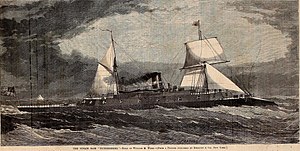 The steam ram Dunderberg, Harper's Weekly, 1867
| |
| History | |
|---|---|
| Name | Dunderberg |
| Namesake | Swedish: "thunder(ing) mountain" |
| Ordered | 3 July 1862 |
| Builder | William H. Webb, New York City |
| Laid down | by 3 October 1862 |
| Launched | 22 July 1865 |
| Fate | Not accepted by U.S.N. Sold to France by 7 May 1867 |
| Name | Rochambeau |
| Namesake | Comte de Rochambeau |
| Acquired | by 7 May 1867 |
| Commissioned | 7 August 1867 |
| Renamed | 7 August 1867 |
| Stricken | 15 April 1872 |
| Fate | Scrapped, 1874 |
| General characteristics (in French service, 1868) | |
| Type | Casemate ironclad |
| Displacement | 7,849 metric tons (7,725 long tons) |
| Length | 107.4 m (352 ft 4 in) (p/p) |
| Beam | 22.15 m (72 ft 8 in) |
| Draft | 6.5 m (21 ft 4 in) (mean) |
| Depth | 7.078 m (23 ft 2.7 in) |
| Installed power | |
| Propulsion | 1 shaft, 2 Horizontal back-acting steam engines |
| Sail plan | Brigantine rig |
| Speed | 14.5 knots (26.9 km/h; 16.7 mph) |
| Range | 2,200 kilometres (1,200 nmi) at 8 knots (15 km/h; 9.2 mph) |
| Complement | 600 |
| Armament |
|
| Armor |
|
Dunderberg, which is a Swedish word meaning "thunder(ing) mountain",[1] was an ocean-going casemate ironclad of 14 guns built for the Union Navy. She resembled an enlarged, two-masted version of the Confederate casemate ironclad CSS Virginia. She was originally designed to have both gun turrets and a casemate but the turrets were deleted while the ship was still being built. Construction began in 1862, but progress was slow and she was not launched until after the end of the American Civil War in 1865.
The ship was not accepted by the Union Navy so her builder began seeking buyers elsewhere; Otto von Bismarck expressed some interest, and the thought of Prussia armed with such a vessel prompted France to purchase her and commission her in 1867 with the name Rochambeau. She was initially placed in reserve, but was mobilized in 1870 to participate in the Franco-Prussian War. The ship saw no action and was decommissioned after the end of the war. Rochambeau was stricken from the Navy Directory in 1872 and scrapped in 1874.
- ^ "Dunderberg". Dictionary of American Naval Fighting Ships. Navy Department, Naval History and Heritage Command. Retrieved 1 January 2013.